|
Back
to Illustrated Sites of Greece
Castalian
Spring
Corycian
Cave and Environs
Marmara
at Delphi
The Delphi
Museum Gallery
Mount
Parnassos
Up the
Sacred Way
The Stadium at
Delphi
The Temple of
Apollo
The Theater at
Delphi
|
 |
|
Dr. J's Illustrated Sacred Way
at Delphi |
 A misty view
of the Sacred Way of Delphi, with the Phaedriades, or "Shining Rocks," as a
backdrop. It is difficult to discern, but the Way winds its way up the mountain in a
series of serpentine turns, offering showcases at every turn for the votive offerings left
behind by grateful city-states and island colonies. Delphi achieved the height of its fame
during the 6th century BC, as Greece passed from the Archaic to the Classical Age. But
stories from before and since abound: an old tale tells that Aesop met his death by being
thrown from these very rocks, the punishment for mocking the gods. A misty view
of the Sacred Way of Delphi, with the Phaedriades, or "Shining Rocks," as a
backdrop. It is difficult to discern, but the Way winds its way up the mountain in a
series of serpentine turns, offering showcases at every turn for the votive offerings left
behind by grateful city-states and island colonies. Delphi achieved the height of its fame
during the 6th century BC, as Greece passed from the Archaic to the Classical Age. But
stories from before and since abound: an old tale tells that Aesop met his death by being
thrown from these very rocks, the punishment for mocking the gods. |
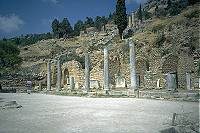 Greek
city-states engaged in terrific one-upsmanship when it came to erecting votives to the
oracle. For example, in this niche were showcased 37 bronze statues. They celebrated the
Spartans' victory over the Athenians at Aegospotamoi in 404 BC, ending the Peloponnesian
War and Athens' supremacy among Greek city-states. The monument was purposely erected
directly across the Way from the Athenian monument celebrating victory at Marathon, which
originally only held 13 statues (although those were made by Pheidias himself!). Greek
city-states engaged in terrific one-upsmanship when it came to erecting votives to the
oracle. For example, in this niche were showcased 37 bronze statues. They celebrated the
Spartans' victory over the Athenians at Aegospotamoi in 404 BC, ending the Peloponnesian
War and Athens' supremacy among Greek city-states. The monument was purposely erected
directly across the Way from the Athenian monument celebrating victory at Marathon, which
originally only held 13 statues (although those were made by Pheidias himself!). |
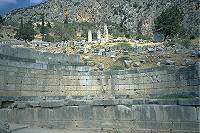 The
Kings of Argos monument also had a political message. The Argives celebrate their alliance
with Thebes, together with whom they founded Messene in 369 BC. As a group, they stood
against Spartan domination in southern Greece. This monument fostered good feelings
between Thebes and Argos, mythical enemies but real-life allies against Sparta. The
Kings of Argos monument also had a political message. The Argives celebrate their alliance
with Thebes, together with whom they founded Messene in 369 BC. As a group, they stood
against Spartan domination in southern Greece. This monument fostered good feelings
between Thebes and Argos, mythical enemies but real-life allies against Sparta. |
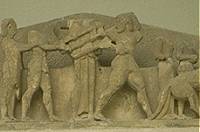 The Sacred Way was once lined with tens of
buildings called "Treasuries," literally "place where gold things are
put," which housed the valuable and beautiful votive offerings provided by individual
city-states and colonies. As a political oracle, Delphi served states, not
individuals, and was rewarded by same. This frieze from the Siphnian Treasury (525 BC)
survives and is on display in the Delphi Museum: it tells the story of how Herakles once
came here and challenged Apollo for his tripod, the seat of his power. The Sacred Way was once lined with tens of
buildings called "Treasuries," literally "place where gold things are
put," which housed the valuable and beautiful votive offerings provided by individual
city-states and colonies. As a political oracle, Delphi served states, not
individuals, and was rewarded by same. This frieze from the Siphnian Treasury (525 BC)
survives and is on display in the Delphi Museum: it tells the story of how Herakles once
came here and challenged Apollo for his tripod, the seat of his power. |
 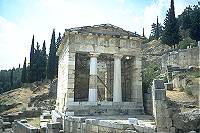 The
Athenian Treasury is the only one to have been reconstructed (except for its roof, as the
photo on the right shows). Not only the votives found inside, but the building itself
stands as official Athenian thanks to the Oracle after their victory at Marathon in 490
BC. The political nature of this game is apparent here: although the Athenians were not
favored by the oracle, they nevertheless established this shrine in a show of undeserved
but politically correct gratitude and paid for it with the spoils from their successful
rout of the Persians. The
Athenian Treasury is the only one to have been reconstructed (except for its roof, as the
photo on the right shows). Not only the votives found inside, but the building itself
stands as official Athenian thanks to the Oracle after their victory at Marathon in 490
BC. The political nature of this game is apparent here: although the Athenians were not
favored by the oracle, they nevertheless established this shrine in a show of undeserved
but politically correct gratitude and paid for it with the spoils from their successful
rout of the Persians. |
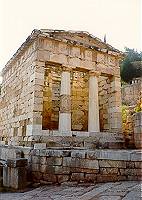 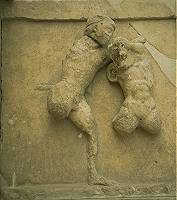 The metopes from the Treasury of the Athenians depict the labors
of Herakles and Theseus' victory over the Minotaur (right), as displayed in the Delphi
Museum, and its original home (left). By associating Theseus with Herakles, the Athenians
hoped to universalize their local Attic hero, Theseus. The rear wall was covered with more
than 150 inscriptions, including a hymn to Apollo complete with musical notation. The metopes from the Treasury of the Athenians depict the labors
of Herakles and Theseus' victory over the Minotaur (right), as displayed in the Delphi
Museum, and its original home (left). By associating Theseus with Herakles, the Athenians
hoped to universalize their local Attic hero, Theseus. The rear wall was covered with more
than 150 inscriptions, including a hymn to Apollo complete with musical notation. |
 There is a
reason that Delphi became such a significant site in Greek history, religion and politics:
when Zeus sent forth two eagles from far-flung corners of the earth in search of the
center of the world, they met here, over Delphi. This omphalos, Greek for
"belly-button," marks sacred Delphi as that center. This is just a concrete
representation; the original omphalos was housed inside the adyton of the Temple of
Apollo. Even by Pausanias' time it had been replaced. There is a
reason that Delphi became such a significant site in Greek history, religion and politics:
when Zeus sent forth two eagles from far-flung corners of the earth in search of the
center of the world, they met here, over Delphi. This omphalos, Greek for
"belly-button," marks sacred Delphi as that center. This is just a concrete
representation; the original omphalos was housed inside the adyton of the Temple of
Apollo. Even by Pausanias' time it had been replaced. |
 The
Rock of the Sibyl Herophile, immediately below the Temple terrace. Pausanias claims that
she is the one who composed the Hymn to Apollo while under the influence of the god Apollo
(10.12.1) The
Rock of the Sibyl Herophile, immediately below the Temple terrace. Pausanias claims that
she is the one who composed the Hymn to Apollo while under the influence of the god Apollo
(10.12.1) |
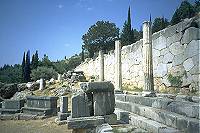  The
columns in the photo on the left mark the 30 meter long Stoa of the Athenians, where in
478 BC they displayed war trophies taken from the Persians. The inscription refers
specifically to thwarting Xerxes' ingenious plan to cross the Hellespont using
tied-together ships as a bridge. Pausanias mistakenly attributes this to the Peloponnesian
War era. (X.2.4-5) The Sphinx of the Naxians, 570-560 BC (right), towered into the air
right next to it: the 8 foot tall (2 1/2 meter) sphinx sits atop a 44-flute Ionic column
that towered 35 feet (11 1/2 meters) into the air. The
columns in the photo on the left mark the 30 meter long Stoa of the Athenians, where in
478 BC they displayed war trophies taken from the Persians. The inscription refers
specifically to thwarting Xerxes' ingenious plan to cross the Hellespont using
tied-together ships as a bridge. Pausanias mistakenly attributes this to the Peloponnesian
War era. (X.2.4-5) The Sphinx of the Naxians, 570-560 BC (right), towered into the air
right next to it: the 8 foot tall (2 1/2 meter) sphinx sits atop a 44-flute Ionic column
that towered 35 feet (11 1/2 meters) into the air. |
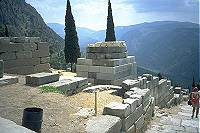 One
of the most celebrated monuments of antiquity, the Tripod of Plataea celebrated the defeat
of the Persians by 31 Greek city-states at
Plataea in 479 BC and was
financed by 1/10 their spoils. Three intertwined serpents made of gold supported a gold
cauldron. Constantine the Great removed the monument to his Hippodrome, and fragments
of it are still on display today in Istanbul. One
of the most celebrated monuments of antiquity, the Tripod of Plataea celebrated the defeat
of the Persians by 31 Greek city-states at
Plataea in 479 BC and was
financed by 1/10 their spoils. Three intertwined serpents made of gold supported a gold
cauldron. Constantine the Great removed the monument to his Hippodrome, and fragments
of it are still on display today in Istanbul. |
 The
Temple of Apollo, the sine qua non of the Sacred Way, is so important that it has its own
Illustrated Temple of Apollo Page. The
Temple of Apollo, the sine qua non of the Sacred Way, is so important that it has its own
Illustrated Temple of Apollo Page. |
|
